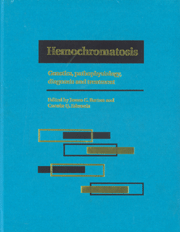Book contents
- Frontmatter
- Contents
- List of contributors
- Foreword
- Part I Introduction to hemochromatosis
- Part II Genetics of hemochromatosis
- 3 Inheritance of hemochromatosis: family studies
- 4 Hemochromatosis: population genetics
- 5 Variation of hemochromatosis prevalence and genotype in national groups
- 6 Human leukocyte antigen (HLA) association and typing in hemochromatosis
- 7 Localization, allelic heterogeneity, and origins of the hemochromatosis gene
- 8 The ancestral haplotype in hemochromatosis
- 9 Evidence for multiple hemochromatosis genes
- Part III Metal absorption and metabolism in hemochromatosis
- Part IV Diagnostic techniques for iron overload
- Part V Complications of iron overload
- Part VI Therapy of hemochromatosis and iron overload
- Part VII Infections and immunity in hemochromatosis
- Part VIII Hemochromatosis heterozygotes
- Part IX Relationship of hemochromatosis to other disorders
- Part X Animal models of hemochromatosis and iron overload
- Part XI Screening for hemochromatosis
- Part XII Hemochromatosis: societal and ethical issues
- Part XIII Final issues
- Index
5 - Variation of hemochromatosis prevalence and genotype in national groups
from Part II - Genetics of hemochromatosis
Published online by Cambridge University Press: 05 August 2011
- Frontmatter
- Contents
- List of contributors
- Foreword
- Part I Introduction to hemochromatosis
- Part II Genetics of hemochromatosis
- 3 Inheritance of hemochromatosis: family studies
- 4 Hemochromatosis: population genetics
- 5 Variation of hemochromatosis prevalence and genotype in national groups
- 6 Human leukocyte antigen (HLA) association and typing in hemochromatosis
- 7 Localization, allelic heterogeneity, and origins of the hemochromatosis gene
- 8 The ancestral haplotype in hemochromatosis
- 9 Evidence for multiple hemochromatosis genes
- Part III Metal absorption and metabolism in hemochromatosis
- Part IV Diagnostic techniques for iron overload
- Part V Complications of iron overload
- Part VI Therapy of hemochromatosis and iron overload
- Part VII Infections and immunity in hemochromatosis
- Part VIII Hemochromatosis heterozygotes
- Part IX Relationship of hemochromatosis to other disorders
- Part X Animal models of hemochromatosis and iron overload
- Part XI Screening for hemochromatosis
- Part XII Hemochromatosis: societal and ethical issues
- Part XIII Final issues
- Index
Summary
Introduction
Once considered to be a rare disorder, hemochromatosis is now recognized as the most common known autosomal recessive disorder in Caucasians, which occurs commonly in many European or European-derived populations. The major factor leading to this recognition was the clarification of its genetic mode of transmission. The finding by Simon and co-workers of the association of hemochromatosis with the MHC class I antigen HLA-A3 and the subsequent demonstration of the haplotypic nature of that association marked the beginning of a new era in the clarification of the true frequency of hemochromatosis. Assignment of a genotype on the basis of HLA typing has permitted an estimate of frequencies of the disorder in several areas of the world that are greater than the calculations previously based on the identification of clinical symptoms or on the findings of autopsy studies. The recent finding by Feder and co-workers of the HFE gene, one mutation which accounts for the majority of hemochromatosis patients, permits a new approach to the study of the epidemiology of the disorder. In spite of the frequency of hemochromatosis in most Caucasian populations, there is considerable variation in its prevalence among different countries and even within national boundaries. This chapter provides an overview of the geographical variations of the HLA phenotypes marking the HFE gene and of the HFE genotypes found in hemochromatosis patients and normal populations throughout the world, and offers some explanations for the variations observed.
- Type
- Chapter
- Information
- HemochromatosisGenetics, Pathophysiology, Diagnosis and Treatment, pp. 51 - 62Publisher: Cambridge University PressPrint publication year: 2000
- 16
- Cited by



